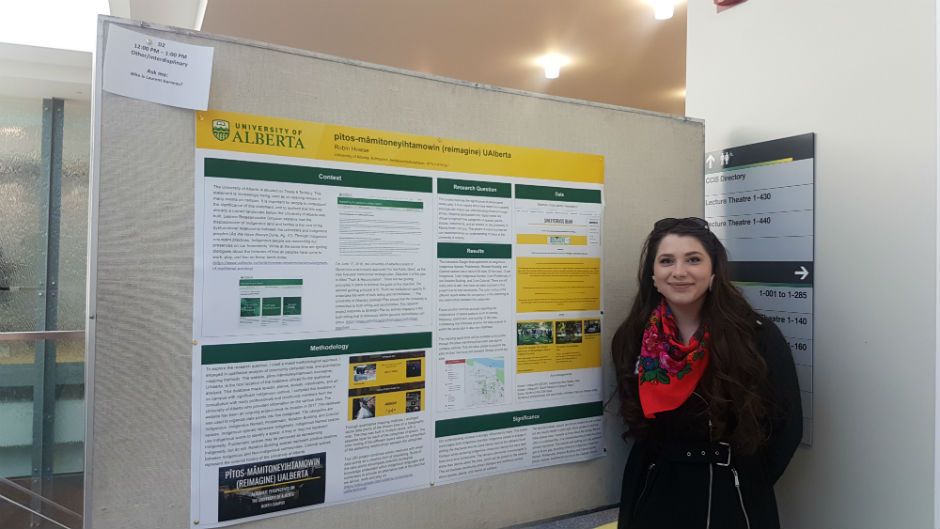
Robin Howse with her poster for pîtos-mâmitoneyihtamowin (reimagine) UAlberta at the Festival of Undergraduate Research 2019
A website and walking map created by Native Studies undergraduate student Robin Howse is providing background and context into the buildings, art and spaces of the University of Alberta.
The project is titled pîtos-mâmitoneyihtamowin (reimagine) UAlberta, and its website lists a number of prominent campus sites that have, or seem to have, Indigenous or colonial ties. Some of these include Sweetgrass Bear, Nîpisîy House, Rutherford House and the Faculty of Native Studies' tipi. Information about each is provided, including related links, and the sites are mapped and then organized into five categories: Indigenous, Problematic, Colonial, Relation-Building, and Indigenous-Named.
"The way you understand place and place names impacts how you see the world and how you interact with it politically, socially, economically, and how you're going to solve problems," Howse said.
Howse noted that professors Nathalie Kermoal and Dwayne Donald have also each done research into the history of the place the U of A now resides on.
"There are so many people doing this, a lot of this information is out there, so I wanted to create a hub for it," explained Howse.
Providing that information in an accessible place is important for Howse.
"Once people are able to understand the complex history of this space, they can understand more of our contemporary issues and why things are the way they are. Just understanding that this place was already named before the university came along and expressed dominion over it changes your understanding of it," she said.
Howse points to the statue in front of the South Academic Building as a good example of this change in understanding. The statue is of U of A founders Alexander Rutherford and Henry Marshall Tory looking at a map of the land the university would eventually be built on-at the time a collection of river lots.
"It's titled 'The Visionaries,' so the university sees Rutherford and Tory as these awesome men with their map, envisioning what this land could be. Whereas other people see it as Rutherford and Tory plotting out how they're going to steal this land."
Highlighting and mapping the current sites on campus is about more than providing historical or contemporary information. Naming places is a political action, said Howse.
"Those who are in charge of naming places and creating maps usually control the discourse around our spaces," she explained.
"The importance of mapping things and looking at the original names of things is that it lets you realize that these places are dynamic and changing, and lets you know that there is a presence here that has been affected by systematic forces."
Howse's focus on the importance of names includes the name of her own project: pîtos-mâmitoneyihtamowin (reimagine) UAlberta. As she wasn't fluent in Cree herself, Howse worked with Cree language instructor Dorothy Thunder to name the project.
"The title had to be Cree because [the project] is about getting people to re-conceptualize and rethink, and when you learn a new language, especially an Indigenous language, or if you know an Indigenous language, you see the world in a totally different way."
Howse's project was awarded the Community Connections Award at the Festival of Undergraduate Research (FURCA) in March, 2019.The award is intended to recognize outstanding research that bridges communities on or off-campus.